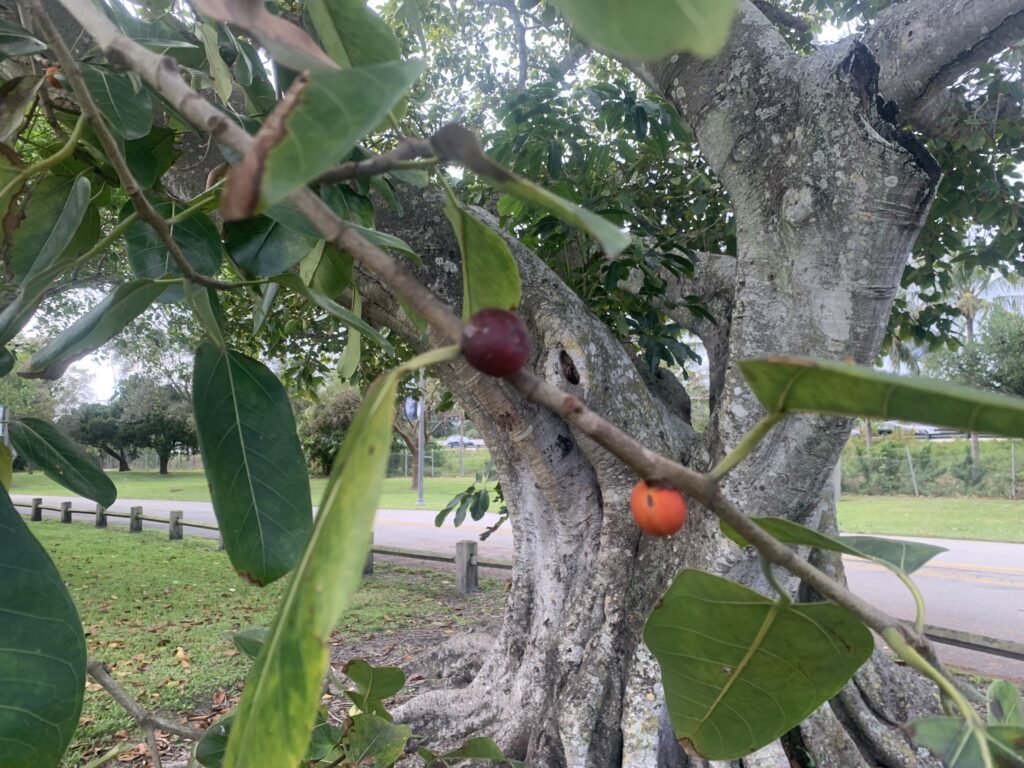
Fruit ripening on a Ficus benghalensis, aka Ficus Audrey and strangler fig. Photo by Green Deane
Strangler figs get a bad rap, perhaps deservedly so. They slowly take over a tree or palm and kill their host while living on them. But they are also edible figs, and there are three of them locally (eleven different species in the state.) One is from India, a native one and an export from business offices. As a food these figs can range from dry tasteless sponges to sweet or fermented. The species are Ficus benghalensis (red fruit) Ficus aurea (Florida strangler fig, yellow fruit) and Ficus Benjamina (the Weeping Fig and a common office plant and a major source of indoor allergens. The fruit can be dark purple.) If any of these starts life growing on some other plant it is called a Strangler Fig, if it starts on the ground and has multiple trunks it is called a Banyan. They can live to 500 years and cover several acres. The fruit of the F. benghalensis is hard when orange, and softens as it turns red or purple. They were eaten by native and settlers alike. Ariel roots were used for bow strings, rope and fishing lines. The extra roots allow the tree to grow faster than its host thus engulfing it.
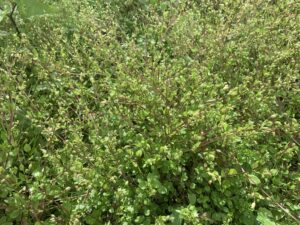
Blossoming chickweed east of Tampa. Photo by Green Deane
Chickweed is a common winter species in Florida, usually from the central part of the state north. Surprisingly we saw some about 30 miles east of Tampa this week. The first time in decades of foraging finding chickweed south of greater Orlando. A short-season winter vegetable, it is related to West Indian Chickweed which can be found all year here. Real Chickweed, Stellaria media, tastes like corn silk or raw corn, West Indian Chickweed, drymaria cordata, which likes damp soil, has no particular flavor. Inoffensive West Indian Chickweed is often used as a garnish. Also seen fruiting heavily now is American nightshade, Solanum americanum. Sow thistle (Sonchus genus) are also blossoming profusely.

Foraging classes are held rain, shine, hot or cold. Photo by Nermina Krenata
Foraging Classes: As the weather is becoming more consistent hopefully it won’t cause anymore class cancellations:
Saturday, January 27th, Mead Garden, 1500 S. Denning Dr., Winter Park, FL 32789. Meet at the bathrooms, 9 a.m. to noon.
Sunday, January 28th, Eagle Lake Park, 1800 Keene Road, Largo, FL 33771. Meet at the pavilion near the dog park. 9 a.m. to noon.
Saturday, February 3rd, Dreher Park, 1200 Southern Blvd., West Palm Beach, 33405. 9 a.m. to noon. Meet just north of the science center.
To read more about the classes, to pre-pay or sign up, go here.
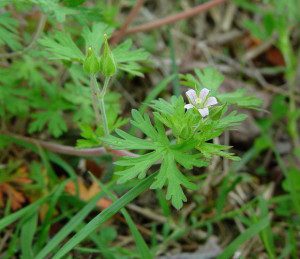
Wild Geraniums are a common seasonal lawn weed. Photo by Green Deane
Also found in lawns this time of year are wild geraniums, usually Cranesbill or Stork’s Bill. (Why one is one word and the other two-words possessive I do not know.) Botanically they are Geranium carolinianum and Erodium circutarium. Neither is great foraging. In fact both are more medicinal than edible but they seem to get mention in a variety of foraging books. The problem is they are extremely bitter. You might be able to toss a little bit of both in a salad but that’s about the extent of it. If you have what you think is a Cranesbill or a Stork’s Bill but it has more of a bottle brush blossom than five petals you might have the non-edible Fumaria. It comes up this time of year and from a distance the leaves can remind one of the wild geraniums. To read more about them go here.
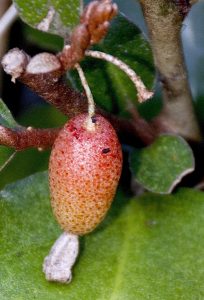
Silverthorn berries ripen in Feburary.
Another seasonal species to be looking for is Silverthorn one of the few fruits that sets in our winter and is usually ripe about Valentine’s Day. That’s handy because the jelly-bean sized fruit is red with a gold netting or spray on it. But, if you remember the red fruit is ready around Valentine’s Day you’ll be looking for it. The boxy blossoms help you identify which shrubs will be producing fruit this year. It’s a common landscape plant and also an escapee. New fruit likes to grow on new growth and with waxy leaves the species is fairly easy to identify. Even though the fruit is small it has the distinction of having the highest amount of the antioxidant lycopene per weight of any fruit. You can read about Silverthorn here and watch a video here.

You get the USB, not the key.
172-video USB would be a good end of spring present and is now $99. My nine-DVD set of 135 videos has been phased out. The USB videos are the same videos I have on You Tube. Some people like to have their own copy. The USB videos have to be copied to your computer to play. If you want to order the USB go to the DVD/USB order button on the top right of this page. That will take you to an order form. I’d like to thank all of you who ordered the DVD set over the years which required me to burn over 5,000 DVDs individually.

Green Deane Forum
Want to identify a plant? Perhaps you’re looking for a foraging reference? You might have a UFO, an Unidentified Flowering Object, you want identified. On the Green Deane Forum we — including Green Deane and others from around the world — chat about foraging all year. And it’s not just about warm-weather plants or just North American flora. Many nations share common weeds so there’s a lot to talk. There’s also more than weeds. The reference section has information for foraging around the world. There are also articles on food preservation, and forgotten skills from making bows to fermenting food.
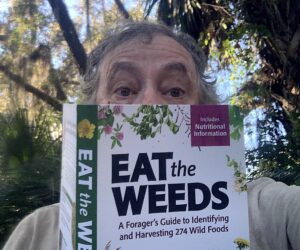
Finally, a physical copy of the book.
Now in print is EatTheWeeds, the book. It has 275 plants, 367 pages, index, nutrition charts and color photos. It’s available in many locations including Amazon. Most of the entries include a nutritional profile.
This is weekly newsletter #585. If you want to subscribe to this free newsletter you can find the sign-up form in the menu at the top of the page.
This newsletter is late because mail chimp is increasingly difficult to work with. Any one have a suggestion for a mailing service?

